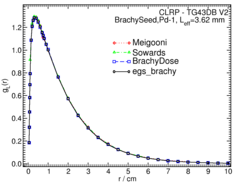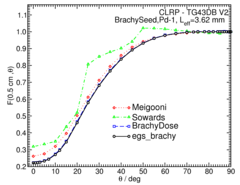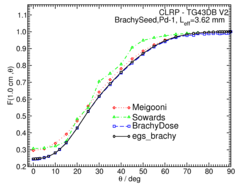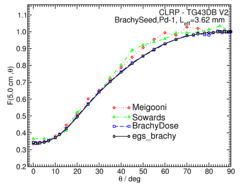
Source Description:
Dimensions for the Advantage IAPd-103A source 1, 2 are from the study by Meigooni et al 1 and Sowards 2. The IsoAid Advantage 103Pd seed contains four spherical polystyrene beads with diameters of 0.50 mm. The 103Pd for this source is assumed to be distributed uniformly throughout the volume of the four beads. The four beads are separated into two pairs by a cylindrical silver marker that is 0.50 mm in diameter and 1.250 mm long. The centers of the two beads within a pair are offset by ± 0.968 mm and ± 1.560 mm from the source center. The source is encapsulated in a titanium casing 0.050 mm thick with an outside diameter of 0.80 mm. The end welds have a maximum thickness of 0.350 mm and are modelled using a 0.405 mm radius Ti hemisphere overlapped with a 0.890 mm radius air sphere with its center shifted by 0.840 mm relative to the Ti sphere. The overall source length is 4.50 mm and the active length is 3.620 mm. The study of Meigooni et al 1, and Sowards 2 supposed the active length of the source is 3.61 mm, 3.4 mm, respectively. The maximum possible displacement of a source sphere is 0.459 mm along the seed axis and up to 0.070 mm in the radial direction, however, we assume the two beads are always centred. The mean photon energy calculated on the surface of the source is 20.51 keV with mean statistical uncertainties < 0.01%.
(Note: Results from Taylor and Rogers 7 for this seed mistakenly included a cylindrical shell of water around the seed, which was affecting the air-kerma and dose-rate calculation).
Dose-Rate Constant - Λ :
Dose-rate constants, Λ , are calculated by dividing the dose to water per history in a (0.1 mm)3 voxel centered on the reference position, (1 cm, Π/2), in a 30x30x30 cm3 water phantom, by the air-kerma strength per history (scored in vacuo ). As described in ref. 3 , dose-rate constants are provided for air-kerma strength calculated using voxels of 2.66x2.66x0.05 cm3 (WAFAC) and 0.1x0.1x0.05 cm3 (point) located 10 cm from the source. The larger voxel size averages the air-kerma per history over a region covering roughly the same solid angle subtended by the primary collimator of the NIST WAFAC 4, 5 used for calibrating low-energy brachytherapy sources and is likely the most clinically relevant value. The small voxel serves to estimate the air kerma per history at a point on the transverse axis and includes a small 1/r2 correction (0.5%) 3. egs_brachy and BrachyDose uncertainties are only statistical uncertainties (k=1).
| Author | Method | Λ (cGy h-1 U-1) | Abs. Uncertainty |
| Safigholi et al 6 | WAFAC | 0.6591 | 0.0001 |
| Safigholi et al 6 | Point | 0.6579 | 0.0013 |
| Taylor, Rogers 7 | WAFAC | 0.687* | 0.002 |
| Taylor, Rogers 7 | Point | 0.687* | 0.002 |
| Meigooni et al 1 | Extrap (PTRAN) | 0.67 | 0.03 |
| Meigooni et al 1 | TLD (Solid Water) | 0.68 | 0.08 |
| Sowards 2 | Point (PTRAN) | 0.709 | 0.014 |
| Rodriguez, Rogers 8 | TLD (Revised Meigooni) | 0.675 | 0.049 |
| Rodriguez, Rogers 9 | WAFAC (BrachyDose) | 0.661 | 0.002 |
| Rivard et al 10 | TG-43U1S2 (Consensus Value) | 0.693 | 0.031 |
* Taylor-Rogers values 7 differ from the current values 6 due to changes in how the seed is modelled.
Radial dose function -g(r):
The radial dose function, g(r), is calculated using both line and point source geometry functions and tabulated at 36 different radial distances ranging from 0.05 cm to 10 cm. Fit parameters for a modified polynomial expression are also provided 11. The mean residual deviations from the actual data for the best fit were < 0.11%.
| Fitting coefficients for g L (r) = (a0 r-2 + a1 r-1 + a2 + a3r + a4r2 + a5 r3) e-a6r | |||
| Fit range | Coefficients | ||
| r min (cm) | r max (cm) | ||
| 0.09 | 10.00 | a0 / cm2 | (-6.5+/-0.4)E-04 |
| a1 / cm | (-9.12+/-0.05)E-02 | ||
| a2 | (1.8025+/-0.0027)E+00 | ||
| a3 / cm-1 | (2.13+/-0.15)E-01 | ||
| a4 / cm-2 | (-4.18+/-0.06)E-02 | ||
| a5 / cm-3 | (3.05+/-0.07)E-03 | ||
| a6 / cm-1 | (6.37+/-0.07)E-01 | ||
Anisotropy function - F(r,θ):
Anisotropy functions are calculated using the line source approximation and tabulated at radii of 0.1, 0.15, 0.25, 0.5, 0.75, 1, 2, 3, 4, 5, 7.5 and 10 cm and 32 unique polar angles with a minimum resolution of 5° . The anisotropy factor, φan (r), was calculated by integrating the solid angle weighted dose rate over 0° ≤ ϑ ≤ 90°.
Tabulated data:
Tabulated data are available in .xlsx format: Excel
References:
1. A. S. Meigooni et al , Experimental and Monte Carlo dosimetric characterization of Advantage 103 Pd, Appl. Radiat. Isotopes, 64 , 881-887, 2006.
2. K. Sowards, Monte Carlo dosimetric characterization of the IsoAid Advantage 103 Pd brachytherapy source, J. Appl. Clin. Med. Phys., 8 , 18 - 25, 2007.
3. R. E. P. Taylor et al , Benchmarking BrachyDose: voxel-based EGSnrc Monte Carlo calculations of TG-43 dosimetry parameters, Med. Phys., 34 , 445 - 457, 2007.
4. R. Loevinger, Wide-angle free-air chamber for calibration of low--energy brachytherapy sources, Med. Phys., 20 , 907, 1993
5. S. M Seltzer et al , New National Air-Kerma-Strength Standards for 125 I and 103 Pd Brachytherapy Seeds, J. Res. Natl. Inst. Stand. Technol., 108 , 337 -- 358, 2003.
6. H. Safigholi, M. J. P. Chamberland, R. E. P. Taylor, C. H. Allen, M. P. Martinov, D. W. O. Rogers, and R. M. Thomson, Updated of the CLRP TG-43 parameter database for LDR low-energy brachytherapy sources, to be published (Current calculation). 7. R. E. P. Taylor, D. W. O. Rogers, An EGSnrc Monte Carlo-calculated database of TG-43 parameters, Med. Phys., 35 , 4228-4241, 2008. 8. M. Rodriguez , D. W. O. Rogers, Effect of improved TLD dosimetry on the determination of dose rate constants for 125I and 103Pd brachytherapyseeds,Med.Phys.41,114301,15, 2014. 9. M. Rodriguez, D. W. O. Rogers, On determining dose rate constants spectroscopically, Med. Phys. 40 , 011713-10, 2013. 10. M. Rivard et al , Supplement 2 for the 2004 update of the AAPM Task Group No. 43 Report: Joint recommendations by the AAPM and GEC-ESTRO, Med. Phys. 44 , e297-e338, 2017.
11. R. E. P. Taylor, D. W. O. Rogers, More accurate fitting of 125 I and 103 Pd radial dose functions, Med. Phys., 35 , 4242--4250, 2008.



